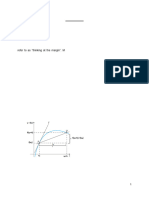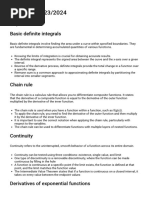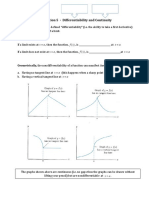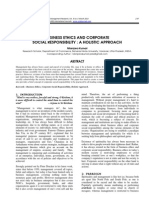AP Calc BC Midterm Study Guide
Uploaded by
annalie3AP Calc BC Midterm Study Guide
Uploaded by
annalie32.
(slope of secant line)
(slope of tangent) Properties of Limits Sum/Difference Rule
Product Rule (Quotient Rule follows same logic) Power Rule
Constant Rule
Sandwich (Squeeze) Theorem
2.2 Limits at Infinity Definition of Horizontal Asymptote
Definition of Vertical Asymptote
2.3 Continuous Functions 3.1 Definition of Derivative
3.2 Differentiability A graph fails to be differentiable: 1) at a corner, 2) when there is a vertical tangent, 3) at a cusp, 4) when it is discontinuous
Intermediate Value Theorem If f is continuous on closed interval [a,b] and c is any number between f(a) and f(b), then there is at least one number x on the interval such that f(x) = c.
Difference Quotient: 3.3 Taking Derivatives Power Rule: Product Rule: Quotient Rule: 3.4 Motion Along a Line Speeding up when v(t) and a(t) are the same sign. Slowing down when v(t) and a(t) are opposite signs. Limit Identities
3.6 Composite Functions and Chain Rule Slopes of Parametrized Curves (x(t), y(t)) is differential at t if x and y are differential at t
d/dt is the derivative of dy/dx d/dx is the actual second derivative 3.7 Implicit Differentiation Differentiate the whole thing with dy/dx. 3.8 Derivative of Inverse f(x) If f is a one-to-one, differential function with inverse g,
Derivatives
Logarithmic Differentiation Take the log or natural log of both sides and differentiate. Usually when there are fractions or a variable in the exponent. 4.1 Absolute/Extreme Values There can be more than one absolute max/min because they have the same y but different x values. There can be a point that is both max and min if the line is a constant horizontal no slope. Absolute Max: Absolute Min: Relative/Local Values Relative Max: at c if Relative Min: at c if
for all x on an interval for all x on an interval
Extreme Value Theorem If f is continuous on [a,b] then f has an absolute max and an absolute min on the interval. 4.2 Mean Value Theorem for Derivatives If f is continuous and [a,b] and differential on (a,b) then there exists at least one point c such that:
(the slope of the tangent = the slope of the secant line through a,b) Definitions Let f be defined on an interval with x1 and x2 as any points on the interval where x1 < x2. Increasing: If x1 < x2 then f(x2) > f(x1) for all of (x1, x2) Decreasing: If x1 < x2 then f(x2) < f(x1) If f(x) = 0 at each point in interval, then f(x) = c If f(x) = g(x) at each point on an interval, then f(x) = g(x) + c 4.3 1st Derivative f(x) increases when f(x) > 0 and decreases when f(x) < 0 f(x) has a max when f(x) changes from + to f(x) has a min when f(x) changes from to +
2nd Derivative When f(x) > 0, f(x) is concave up When f(x) < 0, f(x) is concave down Point of inflection is where the 2nd derivative changes sign 2nd Derivative Test Find CTP (where f(x) = 0 or does not exist) Evaluate the second derivative. If < 0, then concave down and maximum. If > 0, then concave up and minimum. 4.4 Modeling/Optimization (Max/Min) Make an equation out of thte known info and then solve for max or min depending on what you need. Cost and Revenue
Cost function C(x); average cost is minimum when marginal cost (C(x)) equals the average cost. Profit P(x) = R(x) C(x) R(x) = C(x) maximum profit when marginal revenue = marginal cost R(x) = xp(x) where p(x) is the price function (demand) Break even point is when revenue = cost. 4.5 Linearization Given f(x), derive to find f(x), then with given value a, substitute into L(x). Then approximate a new value using L(x). Differentials
Newtons Method Used to approximate zeros and roots.
Calculator
Example is a solution of x2 5. f(x) is x2 5. Pick x1 as 2 or 3 and approximate. 4.6 Related Rates Diagram, then write known and unknowns using Leibniz notation. ie. You have given information, draw a diagram. Given rates of change, write them down as dy/dt or dx/dt, then use given info to come up with an equation, derive, substitute and solve to find the unknown rate. 5.1 Riemann Sum
5.2 Definition of Definite Integral
5.3 Properties of Definite Integral 1) 2) 3) 4) 5) 6) 7) Average Value of a Function
Fundamental Theorem of Calculus Part 1
Part 2
Approximation Methods Trapezoidal Rule
Simpsons Rule Uses a series of parabolic arcs to approximate the curve.
where n must be even 6.1 Antiderivatives Differential Equation an equation that contains a derivative Separation of Variables Move the variables to each side, then integrate. 6.2 Substitution Method Let u and du. Use u(a) and u(b) for limits. 6.3 Integration By Parts
6.4 Exponential Growth/Decay
Newtons Law of Cooling The rate at which an object temperature is changing at any given time is approximately proportional to the difference between its temperature and the surrounding temperature.
6.5 Population Growth
(rate of relative growth) Logistic Differential Equation
6.6 Numerical Methods Eulers Method
2nd Degree Taylor Equation
You might also like
- Lecture 1: Limits, Derivatives, The Product Rule, The Quotient Rule, and The Chain RuleNo ratings yetLecture 1: Limits, Derivatives, The Product Rule, The Quotient Rule, and The Chain Rule41 pages
- AP Calculus AB - Ultimate Guide Notes - KnowtNo ratings yetAP Calculus AB - Ultimate Guide Notes - Knowt29 pages
- Compilation of Important Calculus COncepts v5 SmartNo ratings yetCompilation of Important Calculus COncepts v5 Smart8 pages
- differentiation-StudyGuide by thea for class 12No ratings yetdifferentiation-StudyGuide by thea for class 124 pages
- Derivatives: Definition: The Derivative of A Function F at A Point A, Denoted by F (A), IsNo ratings yetDerivatives: Definition: The Derivative of A Function F at A Point A, Denoted by F (A), Is11 pages
- Differentiation: First Derivative Second DerivativeNo ratings yetDifferentiation: First Derivative Second Derivative11 pages
- Sketch the Grahp- LHopital Rule- OptimizationNo ratings yetSketch the Grahp- LHopital Rule- Optimization7 pages
- Drying Wet Framing JLC June 2013 ArticleNo ratings yetDrying Wet Framing JLC June 2013 Article5 pages
- Business Ethics and Corporate Social Responsibility: A Holistic Approach100% (1)Business Ethics and Corporate Social Responsibility: A Holistic Approach6 pages
- Fundamentals of Security in Operating SystemsNo ratings yetFundamentals of Security in Operating Systems4 pages
- Inbound Logistics. The Majority of Samsung Suppliers Are Based in Asia and AccordinglyNo ratings yetInbound Logistics. The Majority of Samsung Suppliers Are Based in Asia and Accordingly4 pages
- BAKAR INUWA COMPLETE HAUSA NOVEL - Ganya Hub - Page 2No ratings yetBAKAR INUWA COMPLETE HAUSA NOVEL - Ganya Hub - Page 216 pages
- IAC 16 - Regulatory Framework For Business TransactionsNo ratings yetIAC 16 - Regulatory Framework For Business Transactions13 pages
- Limited Liability Partnership LLP AgreementNo ratings yetLimited Liability Partnership LLP Agreement7 pages
- Reading Comprehension Practice Passages Competitive Exams: Airbus Crisis Over100% (1)Reading Comprehension Practice Passages Competitive Exams: Airbus Crisis Over3 pages
- The Secret To Marketing Simulations by ConcentricNo ratings yetThe Secret To Marketing Simulations by Concentric41 pages
- Mechanic (HT, LT Equipments and Cable Jointing)No ratings yetMechanic (HT, LT Equipments and Cable Jointing)43 pages
- Emery 2020 The Importance of Self Care For Improving Student Nurse WellbeingNo ratings yetEmery 2020 The Importance of Self Care For Improving Student Nurse Wellbeing1 page
- Department of Management Sciences: Financial Project Adamjee Insurance CompanyNo ratings yetDepartment of Management Sciences: Financial Project Adamjee Insurance Company85 pages
- Lecture 1: Limits, Derivatives, The Product Rule, The Quotient Rule, and The Chain RuleLecture 1: Limits, Derivatives, The Product Rule, The Quotient Rule, and The Chain Rule
- Compilation of Important Calculus COncepts v5 SmartCompilation of Important Calculus COncepts v5 Smart
- Derivatives: Definition: The Derivative of A Function F at A Point A, Denoted by F (A), IsDerivatives: Definition: The Derivative of A Function F at A Point A, Denoted by F (A), Is
- Differentiation: First Derivative Second DerivativeDifferentiation: First Derivative Second Derivative
- A-level Maths Revision: Cheeky Revision ShortcutsFrom EverandA-level Maths Revision: Cheeky Revision Shortcuts
- Business Ethics and Corporate Social Responsibility: A Holistic ApproachBusiness Ethics and Corporate Social Responsibility: A Holistic Approach
- Inbound Logistics. The Majority of Samsung Suppliers Are Based in Asia and AccordinglyInbound Logistics. The Majority of Samsung Suppliers Are Based in Asia and Accordingly
- BAKAR INUWA COMPLETE HAUSA NOVEL - Ganya Hub - Page 2BAKAR INUWA COMPLETE HAUSA NOVEL - Ganya Hub - Page 2
- IAC 16 - Regulatory Framework For Business TransactionsIAC 16 - Regulatory Framework For Business Transactions
- Reading Comprehension Practice Passages Competitive Exams: Airbus Crisis OverReading Comprehension Practice Passages Competitive Exams: Airbus Crisis Over
- Emery 2020 The Importance of Self Care For Improving Student Nurse WellbeingEmery 2020 The Importance of Self Care For Improving Student Nurse Wellbeing
- Department of Management Sciences: Financial Project Adamjee Insurance CompanyDepartment of Management Sciences: Financial Project Adamjee Insurance Company

























































































